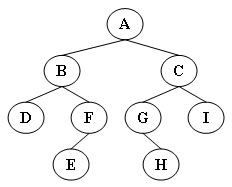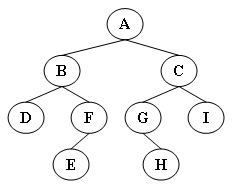数据结构-函数题
6-2.求二叉树的高度
本题要求给定二叉树的高度。
函数接口定义:
int GetHeight( BinTree BT );typedef struct TNode *Position;
typedef Position BinTree;
struct TNode{
ElementType Data;
BinTree Left;
BinTree Right;
};要求函数返回给定二叉树BT的高度值。
裁判测试程序样例:
#include <stdio.h>
#include <stdlib.h>
typedef char ElementType;
typedef struct TNode *Position;
typedef Position BinTree;
struct TNode{
ElementType Data;
BinTree Left;
BinTree Right;
};
BinTree CreatBinTree(); /* 实现细节忽略 */
int GetHeight( BinTree BT );
int main()
{
BinTree BT = CreatBinTree();
printf("%d\n", GetHeight(BT));
return 0;
}
/* 你的代码将被嵌在这里 */?
输出样例(对于图中给出的树):

4?求树的高度的代码?
/*分治思想求二叉树的高度
1.bt为空,则高度为0
2.bt非空,其高度应为其左右子树高度的最大值加1
*/
int GetHeight( BinTree BT )
{
int hl,hr,h;
if(BT!=NULL)
{
hl=GetHeight(BT->Left);
hr=GetHeight(BT->Right);
h=hl>hr?hl:hr;
return h+1;
}
else
return 0;//若为空树
}R6-1 求采用邻接矩阵作为存储结构的无向图各顶点的度?
本题要求实现一个函数,输出无向图每个顶点的数据元素的值,以及每个顶点度的值。
函数接口定义:
void degree(MGraph G);?G为采用邻接矩阵作为存储结构的无向图。
裁判测试程序样例:
#include <stdio.h>
#define MVNum 100 //最大顶点数
typedef struct{
char vexs[MVNum]; //存放顶点的一维数组
int arcs[MVNum][MVNum]; //邻接矩阵
int vexnum,arcnum; //图的当前顶点数和边数
}MGraph;
void degree(MGraph G);
void CreatMGraph(MGraph *G);/* 创建图 */
int main()
{
MGraph G;
CreatMGraph(&G);
degree(G);
return 0;
}
void CreatMGraph(MGraph *G)
{
int i,j,k;
scanf("%d%d",&G->vexnum,&G->arcnum);
getchar();
for(i=0;i<G->vexnum;i++)
scanf("%c",&G->vexs[i]);
for(i=0;i<G->vexnum;i++)
for(j=0;j<G->vexnum;j++)
G->arcs[i][j]=0;
for(k=0;k<G->arcnum;k++)
{
scanf("%d%d",&i,&j);
G->arcs[i][j]=1;
G->arcs[j][i]=1;
}
}
/* 请在这里填写答案 */输入样例:
例如无向图

第一行给出图的顶点数n和边数e。第二行给出n个字符,表示n个顶点的数据元素的值。后面是e行,给出每一条边的两个顶点编号。
4 5
ABCD
0 1
0 2
1 2
1 3
2 3
输出样例:
输出n个顶点的元素值,顶点的数据类型为字符型。以及各顶点的度值
A:2
B:3
C:3
D:2
?求各定点的度的代码
void degree(MGraph G)
{
int i,j;
for(i=0;i<G.vexnum;i++)
{
int du=0;
for(j=0;j<G.vexnum;j++)
{
if(G.arcs[i][j]==1)//如果G.arcs[i][j]!=0,du++;
{
du++;
}
}
printf("%c:%d\n",G.vexs[i],du);
}
}?R6-1 求链式表的表长
本题要求实现一个函数,求链式表的表长。
函数接口定义:
int Length( List L );L是给定单链表,函数Length要返回链式表的长度。
裁判测试程序样例:
#include <stdio.h>
#include <stdlib.h>
typedef int ElementType;
typedef struct LNode *PtrToLNode;
struct LNode {
ElementType Data;
PtrToLNode Next;
};
typedef PtrToLNode List;
List Read(); /* 细节在此不表 */
int Length( List L );
int main()
{
List L = Read();
printf("%d\n", Length(L));
return 0;
}
/* 你的代码将被嵌在这里 */输入样例:
1 3 4 5 2 -1
输出样例:
5
?求表长代码
int Length( List L )
{
LNode *p;
p=L->Next;
int len=0;
while(p!=NULL)
{
p=p->Next;
len++;
}
return len;
}?R6-2 求二叉树的深度
本题要求实现一个函数,可返回二叉树的深度。
函数接口定义:
int Depth(BiTree T);
T是二叉树树根指针,函数Depth返回二叉树的深度,若树为空,返回0。
裁判测试程序样例:
#include <stdio.h>
#include <stdlib.h>
typedef char ElemType;
typedef struct BiTNode
{
ElemType data;
struct BiTNode *lchild, *rchild;
}BiTNode, *BiTree;
BiTree Create();/* 细节在此不表 */
int Depth(BiTree T);
int main()
{
BiTree T = Create();
printf("%d\n", Depth(T));
return 0;
}
/* 你的代码将被嵌在这里 */输入样例:
输入为由字母和'#'组成的字符串,代表二叉树的扩展先序序列。例如对于如下二叉树,输入数据:
AB#DF##G##C##
输出样例(对于图中给出的树):

4?代码:
int Depth(BiTree T)
{
int hl=0,hr=0,h;
if(T)
{
hl=Depth(T->lchild);
hr=Depth(T->rchild);
h=hl>hr?hl:hr;//其高度为左右子树高度的最大值+1
return h+1;
}
else
return 0;
}?R6-2 顺序表的查找操作
本题要求实现一个函数,要求从顺序表中查找指定元素,并返回第一个查找成功的元素在表中的位置序号,若查找失败,则返回0;
函数接口定义:
int LocateElem(SqList L,ElemType e);
?其中SqList结构定义如下:
typedef struct{
ElemType *elem;
int length;
}SqList;
```
### 裁判测试程序样例:
```c++
#include <stdio.h>
#include <stdlib.h>
#define MAXSIZE 5
typedef int ElemType;
typedef struct{
ElemType *elem;
int length;
}SqList;
void InitList(SqList &L);/*细节在此不表*/
int LocateElem(SqList L,ElemType e);
int main()
{
SqList L;
InitList(L);
ElemType e;
int p;
scanf("%d",&e);
p=LocateElem(L,e);
printf("The position of %d in SequenceList L is %d.",e,p);
return 0;
}
/* 请在这里填写答案 */输入格式:
输入数据有1行,首先给出以-1结束的顺序表元素值(不超过100个,-1不属于顺序表元素),然后是待查找的元素值。所有数据之间用空格分隔。
输入样例:
2 6 4 9 13 -1 2
输出样例:
The position of 2 in SequenceList L is 1.代码:?
int LocateElem(SqList L,ElemType e)
{
int i;
for(i=0;i<L.length;i++)
{
if(L.elem[i]==e)//L.elem[i]
{
return i+1;
}
}
return 0;
}?R6-1 二叉树叶结点计数
实现一个函数,返回二叉树bt中叶结点的数量。
题目保证二叉树中所有元素均为整数。
裁判测试程序样例:
#include "stdio.h"
#include "stdlib.h"
struct BinTree{
int data;
struct BinTree *left;
struct BinTree *right;
};
struct BinTree* createNode(int item){ //创建结点
/* 函数实现细节省略*/
}
struct BinTree* findNode(struct BinTree *bt, int item){ //查找结点
/* 函数实现细节省略*/
}
int insert(struct BinTree *bt, int parent, int dir, int item){ //插入结点
/* 实现细节仅供参考 */
struct BinTree *tmp;
tmp = findNode(bt, parent);
if(!tmp) return 0;
if(dir == 0){
if(tmp->left) return 0;
tmp->left = createNode(item);
if(tmp->left == NULL) return 0;
} else{
if(tmp->right) return 0;
tmp->right = createNode(item);
if(tmp->right == NULL) return 0;
}
return 1;
}
struct BinTree* createBinTree(){ //创建二叉树
/* 实现细节仅供参考 */
int total, data;
scanf("%d", &total);
if(total == 0) return NULL;
scanf("%d", &data);
struct BinTree *bt;
bt = createNode(data);
if(!bt) return NULL;
int parent, dir;
for(int i=1; i<total; i++){
scanf("%d%d%d", &parent, &dir, &data);
insert(bt, parent, dir, data);
}
return bt;
}
int countLeaves(struct BinTree *bt);
int main(){
struct BinTree *bt1, *bt2;
bt1 = createBinTree();
bt2 = createBinTree();
printf("%d\n",countLeaves(bt1));
printf("%d\n",countLeaves(bt2));
return 0;
}
/* 你提交的代码将被嵌入在这儿 */输入样例:

对于图片中的两棵二叉树以及样例测试程序的输入方式:
3
30
30 0 10
30 1 25
4
30
30 0 10
30 1 25
25 0 20
输出样例:
对于样例测试程序的输出方式:
2
2?代码:
/*统计二叉树中叶子结点的数目并没,有次序要求,
可以用三种遍历中的任意一种来完成.
一、后序遍历统计
叶子结点:既没有左孩子,又没有右孩子
*/
int countLeaves(struct BinTree *bt)
{
int cnt=0;
if(bt!=NULL)
{
countLeaves(bt->leftt);
countLeaves(bt->right);
if(bt->left==NULL&&bt->right==NULL)
{
cnt++;
}
}
return cnt;
}
/*
方法二:采用分治方法,如果二叉树为空树,返回0,
如果二叉树只有一个结点 ,返回1
否则为左右子树叶子结点的和
*/
int countLeaves(struct BinTree *bt)
{
int count=0;
if(bt==NULL)
return 0;
else if(bt->left==NULL && bt->right==NULL)
return count+1;
else
{
count=countLeaves(bt->left)+countLeaves(bt->right);
return count;
}
}
?R6-1 按值查找单链表
本题要求实现一个函数,Locate_LinkList(LinkList L, datatype x)函数是在带头结点单链表中查找值为x的结点。函数须返回找到结点的指针,没有找到返回空。
函数接口定义:
LNode *Locate_LinkList(LinkList L, datatype x);
其中?L?和?x?都是用户传入的参数。?L?是单链表的头指针;?x?是需要查找的值。函数须返回找到结点的指针,没有找到返回空。
裁判测试程序样例:
在这里给出函数被调用进行测试的例子。例如:
#define FLAG -1
#include <stdio.h>
#include <malloc.h>
typedef int datatype;
typedef struct node
{
datatype data;
struct node *next;
}LNode, *LinkList;
LinkList Creat_LinkList();/*这里忽略函数的实现*/
LNode *Locate_LinkList(LinkList L, datatype x);
int main()
{
LinkList L;
LNode *p=NULL;
int x;
L = Creat_LinkList();
if(L == NULL)
{
printf("L=NULL,error!");
return 0;
}
scanf("%d",&x);
if(p=Locate_LinkList(L,x)) printf("%d",p->data);
else printf("NOT");
return 0;
}
/* 请在这里填写答案 */输入样例:
在这里给出一组输入。例如:
1 2 3 4 5 6 7 8 9 10 -1
8
输出样例:
在这里给出相应的输出。例如:
8代码:
LNode *Locate_LinkList(LinkList L, datatype x)
{
LNode *p;
p=L->next;
while(p!=NULL&&p->data!=x)//当它不为空并这个数据值不等于x
{
p=p->next;//则找下一个
}
return p;//返回找到该节点的指针
}?R6-1 二叉树的遍历
本题要求给定二叉树的4种遍历。
函数接口定义:
void InorderTraversal( BinTree BT );
void PreorderTraversal( BinTree BT );
void PostorderTraversal( BinTree BT );
void LevelorderTraversal( BinTree BT );
?要求4个函数分别按照访问顺序打印出结点的内容,格式为一个空格跟着一个字符
裁判测试程序样例:
#include <stdio.h>
#include <stdlib.h>
typedef char ElementType;
typedef struct TNode *Position;
typedef Position BinTree;
struct TNode{
ElementType Data;
BinTree Left;
BinTree Right;
};
BinTree CreatBinTree(); /* 实现细节忽略 */
void InorderTraversal( BinTree BT );
void PreorderTraversal( BinTree BT );
void PostorderTraversal( BinTree BT );
void LevelorderTraversal( BinTree BT );
int main()
{
BinTree BT = CreatBinTree();
printf("Inorder:"); InorderTraversal(BT); printf("\n");
printf("Preorder:"); PreorderTraversal(BT); printf("\n");
printf("Postorder:"); PostorderTraversal(BT); printf("\n");
printf("Levelorder:"); LevelorderTraversal(BT); printf("\n");
return 0;
}
/* 你的代码将被嵌在这里 */输出样例(对于图中给出的树):

Inorder: D B E F A G H C I
Preorder: A B D F E C G H I
Postorder: D E F B H G I C A
Levelorder: A B C D F G I E H?
void InorderTraversal( BinTree BT )//中序遍历 (左 根 右)
{
if(BT!=NULL)
{
InorderTraversal(BT->Left);
printf(" %c",BT->Data);
InorderTraversal(BT->Right);
}
}
void PreorderTraversal( BinTree BT )//前序遍历 (根 左 右)
{
if(BT!=NULL)
{
printf(" %c",BT->Data);
PreorderTraversal(BT->Left);
PreorderTraversal(BT->Right);
}
}
void PostorderTraversal( BinTree BT )//后序遍历 (左 右 根)
{
if(BT!=NULL)
{
PostorderTraversal(BT->Left);
PostorderTraversal(BT->Right);
printf(" %c",BT->Data);
}
}
void LevelorderTraversal( BinTree BT )//层序遍历
{
BinTree a[11000];
a[0]=BT;
int len=1;
if(!BT)
{
return;
}
while(1)
{
if(len==0)
return ;
int pos=0;
BinTree b[11000];
for(int i=0;i<len;i++)
{
if(a[i]!=NULL)
printf(" %c",a[i]->Data);
if(a[i]->Left!=NULL)
b[pos++]=a[i]->Left;
if(a[i]->Right!=NULL)
b[pos++]=a[i]->Right;
}
len=pos;
for(i=0;i<len;i++)
a[i]=b[i];
}
}?
本文来自互联网用户投稿,该文观点仅代表作者本人,不代表本站立场。本站仅提供信息存储空间服务,不拥有所有权,不承担相关法律责任。 如若内容造成侵权/违法违规/事实不符,请联系我的编程经验分享网邮箱:chenni525@qq.com进行投诉反馈,一经查实,立即删除!
- Python教程
- 深入理解 MySQL 中的 HAVING 关键字和聚合函数
- Qt之QChar编码(1)
- MyBatis入门基础篇
- 用Python脚本实现FFmpeg批量转换
- 外汇天眼:放弃对波动的偏爱才能追逐趋势!
- 14:00面试,14:07就出来了,问的问题有点变态。。。
- gseaplot3修改一下clusterProfiler默认绘图函数
- IDEA:TomEE 主目录/基目录出错
- 文件销毁,硬盘销毁,数据销毁,物料销毁,专业的事交给专业的公司
- C语言内存管理之(堆内存)
- 火爆GitHub,263k star, Fork 36.1k,前后端开发学习路线图,从此不再懵圈
- Python初学者须知(6)实践——创建一个具有基础功能的计算器和创建一个简单的填词游戏
- 2.5 设计FMEA第五步:风险分析
- 消息中间件之RocketMQ(一)